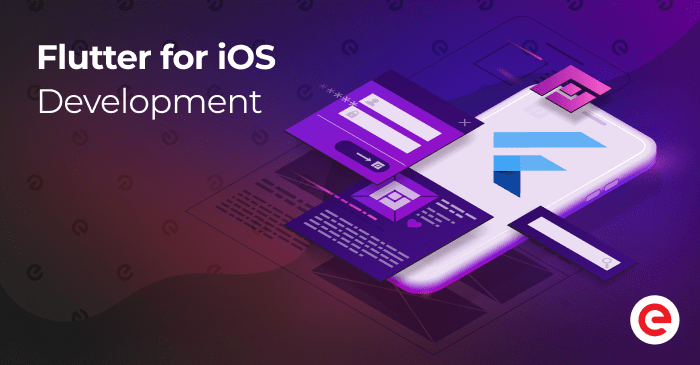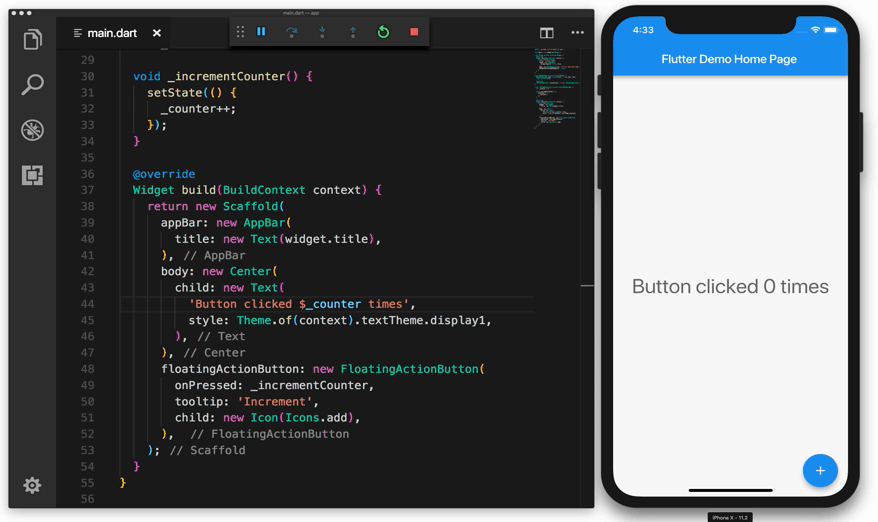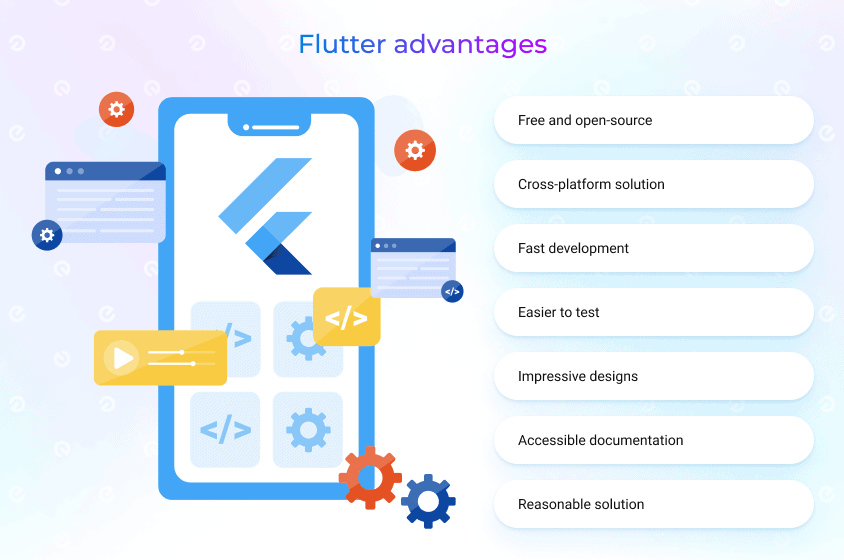
Updated: June 27, 2024
Published: June 25, 2019
Recently, development with Flutter has become a new easy and productive way to create applications. Many teams consider it a possible technology for the next project, which is no surprise since it has advantages of the native framework while being cross-platform. In this article, we’ll focus on how Flutter is different in general and how Flutter for iOS development works in particular.
Now, developers are offered a lot of possibilities by the growing number of frameworks. Flutter is one of the most recent options that has become available for both Android and iOS engineers. The market is full of well-established technologies as well as new ones. The foundation teams and communities work on their constant improvement and develop new front-end frameworks that make programmers’ work easier and faster. Suddenly, a new big player has arrived, and its name is Flutter.
List of the Content
- History of Flutter
- Mobile development with Flutter
- Flutter for iOS development
- Advantages of Flutter for iOS apps
- How popular is Flutter for iOS development
- Conclusion
HISTORY OF FLUTTER
It’s always interesting to discover how one or other technology is evolving. Flutter is worth special attention here. This framework’s success story helps look at app development from completely different perspectives. Even though it was initially created for the Android operating system, the main goal was the support of both major mobile platforms. The same codebase enables smooth performance and eliminates the need to create separate apps for Android and iOS. That benefits the developers and users, who will have a better experience.
The first stable version, Flutter 1.0, with the support of both iOS and Android, was released on the 4th of December, 2018. The Flutter toolkit includes a lot of features that make it a great cross-platform framework. It is characterized by smooth performance, focused on details and UI, and is widely supported by the developers’ community. At the same time, the team was investigating it to support the web. They created a few demos that were successfully performed on desktop and mobile browsers. The results of the project have proved that this framework is an excellent option for web development as well. On the 3rd of May, 2021, the team hit the stable milestone to support web development with Flutter 2.0. Furthermore, they kept advancing toward desktop-class app implementation. One of the great announcements was introducing support to all platforms with Flutter 3.0 released in May 2022. Thus this framework is making substantial changes in the current development approaches. It has already opened new ways for mobile, web and desktop app expansion. Today we’d like to focus more on Flutter iOS development since this is one of the most curious innovations in this technology. And a lot of iOS developers are looking at it as a potential framework for their next big project.
MOBILE DEVELOPMENT WITH FLUTTER FOR IOS AND ANDROID
Providing that Flutter is a relatively new technology in the market, it takes the leading position quite confidently. Since the beginning, the framework has been an open project that attracts more and more app engineers, which speeds up community contribution. Naturally, Google provides guidance and all necessary documentation for those who decide to leverage Flutter for iOS and Android apps. The latest updates are related to the Material design components, iOS widgets, and App Store iOS SDK requirements. Google constantly works on improving its libraries and ecosystem thus, and the learning curve can be gradually followed.
Any Flutter app development company is concentrated on being capable of creating native-like applications whereas having all the advantages of hybrid ones. The framework is based on Google’s in-house programming language, Dart, which enables compilation to the native code of Android and iOS. Therefore, Flutter can deliver distinct functionality and meet users’ expectations covering all the requirements that have become standard for mobile applications today. To advance Flutter’s expansion, Dart was recently upgraded to 2.18 and now features even more cool stuff.
When the iOS developers started to work with this framework, they admitted to the fast development process. Hot Reload is a special tool for building UIs, experimenting and adding features. The developers can observe the changes on the go, which gives the chance to fix the bugs immediately. The framework is capable of rebuilding the widgets automatically. The layered structure supports customization that results in flexible and impressive UIs. Consequently, the app development process is easier and quicker while more cost-effective with Flutter for iOS and Android apps.
Hot reload in Flutter
Moreover, Flutter is able to compete with any highly-rated cross-platform framework. React Native, for example, is one of the biggest competitors developed by Facebook and greatly supported by the community. It has been keeping the leading position for several years due to the same advantages: single code base, simplicity of building, testing, and maintaining, quick delivery time and fewer expenses. As for Flutter for iOS and Android development, the framework covers these advantages, but it does not have any of its flaws so far. It is much younger than React Native, has a promising future that brings new development solutions, and grows in popularity and community approval.
Earlier it might have been emphasized that cross-platform applications could not replace the native ones as long as certain functionality, like iOS gestures, were impossible to achieve with hybrid frameworks. Since Flutter iOS development appeared, these apps have been known for smooth and native-like performance. Cross-platform applications have become a reasonable solution for new-market players and well-known ones.
Why have cross-platform solutions become so popular?
We suggest reading the article with the detailed comparison of Flutter with its competitors. These are known technologies for cross-platform development that have considerably grown in popularity over recent years.
WHY LEVERAGE FLUTTER FOR IOS DEVELOPMENT
This framework has been previously known as a tool capable of working only with Google products like Chrome and Android. Everything changed when Flutter was introduced as the cross-platform framework. The experts admit the native-like performance, overall productivity for iOS developers and other distinctive features. In order to provide this, it uses tools which differ from native iOS ones. Let’s try to find more details about what Flutter for iOS development focuses on.
Dart programming language
Initially, development with Flutter is structured with an absolutely different approach. iOS teams often use Objective-C or Swift, whereas this framework is built on Google’s in-house programming language Dart. Hence the difference. The iOS apps built with Dart perform the distinct functionality as this programming language is capable of compiling to the native iOS code. It uses the special structure that runs the code on the device in the Dart context; thus, there is no need for communication with native modules. It is characterized by simplicity and accessibility. In brief, its engine owns everything for providing native iOS performance without involving other approaches and meets all the requirements by its own structure. The Flutter team presents clear guidance and detailed documentation for their community. Google develops this framework openly with its community members and encourages its developers’ feedback and new solution creation.
Hot reload
Most mobile developers have experienced that feeling when waiting takes more than coding. That is all due to required changes, recompiling, deploying to the device and returning to the point you make the change. Therefore, Flutter for iOS development has presented the hot reload option. This tool modifies the overall development process and allows you to manage changes in the shortest time. Productivity increased tremendously as the time needed for changes decreased to milliseconds. iOS developers and designers enjoy this option as a great collaboration and ideas implementation solution. It enables overall productivity regularly. Flutter for iOS developers also utilizes its dependency management system and does not depend on third-party tools.
Continuous integration and continuous delivery
Traditionally, the Apple team provides the Xcode Server for native iOS applications. In addition, developers can integrate Fastlane and Jenkins as well as other CI/CD systems. This framework offers Codemagic CI/CD approach instead. Nevercode developed it with the purpose of no configuration. That means that Codemagic immediately defines, constructs, tests, and packages mobile apps.
User Interface development
The UI building is a long decision-making process. However, it can be eased with the help of already created solutions. Apple supports UIKit to create powerful and fast interfaces. At the same time, Flutter for iOS development applies its approach where the widgets are used instead of UIView classes. Being immutable and lightweight, the widget can differ by their lifespan and are applied for building complex UIs as a tree of widget instances. Development with Flutter provides the design system guidance by the Material Components library that is flexible for both Android and iOS. In addition, Flutter for iOS development can also leverage the Cupertino widgets.
Testing iOS applications
The testing of native and cross-platform applications will differ as well. The XCTest is a special native tool with numerous features provided by Apple. However, most cross-platform frameworks are known and chosen for the simplicity of testing; there will not be an exception here. Google team provides Flutter Driver to implement the tests as well as detailed documentation on it. Testing includes unit, UI, widget and functional levels. It can check separate processes and run on various devices like real devices, emulators and simulators.
Single-treading for JavaScript
In order to separate the UI code from the background operations, multithreading was introduced in Objective-C. Unfortunately, it has been proved that it does not always happen to be suitable in all cases. On the other hand, Dart engineers apply the JavaScript single-threaded solution. When it is needed, they can manage sequent tasks by async/await and can do an asynchronous task as well. Flutter introduced its own thread-like solution, Isolate, to deal with more complicated tasks.
Finally, this independent framework does not need to run code on a certain platform; its code runs directly on the device in the Dart context. The developers do not depend on iOS or Android APIs as in native applications. This type of app is accommodated in the native ViewController as views; however, they acquire no direct access to it. Successful interaction comes from platform channels that enable data exchange and communication. Their main function is to unite Dart code and the ViewController, as well as an iOS framework for certain tasks. When you are interested in direct interaction, you have the ready options for utilizing plugins. They are available through the Dependency Management System, which is called Hub. It enables numerous tasks connected to navigation, network request, API interactions and the usage of the third-party platform SDKs. Those plugins can meet the needs of iOS or Android and, in most cases, correspond to both of them. Having such distinctive features, Flutter for iOS development has a number of advantages that we will be described next.
Have you decided to build a sophisticated mobile app with Flutter?
Providing the users with the best possible set of features and flexibility is important to Existek. We are glad to seize the opportunity to create cross-platform apps that look and feel native, that’s why we provide exactly Flutter application development services.
FLUTTER FOR IOS DEVELOPMENT ADVANTAGES
Flutter for iOS apps has many pros for any project’s engineering and business sides. It has become one of rather not obvious yet huge surprises that Google is working on making it a fully-fledged web and desktop framework for macOS and Windows. Thus, what started as a mobile app can be relatively easily turned into a web platform or desktop app by the same team.
In general, having such distinctive features, Flutter for iOS development has a number of advantages that we will be described next.
Free and open-source
Flutter for iOS and Android has opened the door to making new marketing approaches. The framework is accessible and free for use by any iOS developer. It is user-friendly and completely open to the community. Google provides users with a lot of diverse options and support. Therefore, open collaboration is a strong foundation for future achievements.
Cross-platform solution
That is really beneficial for companies and developers that need to deal with one codebase for both platforms. Development with Flutter does not rely on a specific platform as it includes its own design and widgets. It is one option for two tasks that can also be differentiated if needed.
Fast development
It is clear that building one codebase will preserve development time and resources. However, another thing should be emphasized in Flutter for iOS development. Teams admitted that a hot reload is a super valuable tool. It helps to manage the changes; thus, they are capable of adding, fixing and testing in a shorter time.
Easier to test
Developing one codebase simplifies testing as it can be tested at once for both platforms. It is also possible to divide it after adding specific features. Moreover, the Google team provides clear, up-to-date documentation on each feature, and Flutter Driver will help check your applications.
Impressive designs
Flutter for iOS and Android development results in wonderfully designed apps. The open collection of widgets enables structural, interactive and visual implementation. They are categorized, easily accessible on the official website, and have clear guidance. The Flutter developer is capable of working on creating new or customizing the existing widgets.
Accessible documentation
If you consider this framework relatively new and not that mature, Google might surprise you here. The company makes continuous improvements and encourages new opportunities. You can easily find all documentation, recent updates, and the strongly supported community.
Reasonable solution
It is specially related to market strategies. On the one hand, Flutter for iOS development increases productivity and improves performance. On the other hand, it simplifies the delivery process and decreases time and costs. Therefore, it will be a great solution for startups, MVPs and big companies that look for flexible approaches.
HOW POPULAR IS FLUTTER FOR IOS DEVELOPMENT?
Flutter now powers both versions of the UI-heavy Google Ads mobile application.
Those who leverage Flutter to build mobile apps leave positive feedback. They acknowledge the surprising simplicity of the development process and impressive final results. A lot of companies have already seized the opportunities of this approach.
It is an excellent decision for different businesses and organizations to address numerous needs. They find Flutter an efficient solution to deploy apps from one codebase to various platforms. Besides using Flutter for iOS and Android, now it can be used for web, desktop and embedded applications.
When the team chooses the technology stack, it’s essential to learn the market state. Even being a relatively new technology, Flutter has considerably gained in popularity. Teams can learn from the experience of others. The number of applications built with Flutter has reached more than 500k.
Let’s check a few app examples that have gained success for their owners, like AppTree, Google Ads, Xianyua, Hamilton Musical, JD Finance, etc.
- AppTree maintains the business platform for numerous companies, including McDonald’s. Flutter is used for making Google Ads that are often chosen for advertising campaigns.
- Xianyu is a cross-platform app of the online marketing company Alibaba.
- Hamilton Musical was created as one of the known and loved Broadway shows with a lot of entertainment.
- The financial technology company JD Finance has also chosen Flutter for the mobility solution.
We can conclude that it is a workable approach for different business domains looking to fulfill their goals. Flutter is a winning solution to deploy robust and sophisticated apps for various platforms while covering business needs regardless of the industry.
Want to find more information on popular applications created with Flutter?
We suggest reading our latest article on popular Flutter solutions to learn from successful experiences and use this knowledge to your advantage.
CONCLUSION
We hope that this blog post helped you to clarify important details on Flutter for iOS development in general and its new ideas for creating your app in particular. Being a new market player, it has already proved its popularity and gained reliable market positions. Both companies and developers enjoy the development process and final product.
Planning to build and successfully launch the mobile application?
Your team should definitely consider Flutter for iOS apps. As a professional Flutter app development company, the Existek team will be glad to share our experience with you and help with your questions.
Frequently asked questions
What is Flutter app development?
This framework is a new way to create applications. The advantage of the native framework enables the development of cross-platform mobile, web, and desktop applications.
How to build iOS app on Flutter?
Initially created for the Android operating system, the main goal was the support of both mobile platforms. Since Flutter for iOS development appeared in December 2018, applications are known for smooth and native-like performance. Flutter for iOS apps has offered distinctive functionality and new opportunities to build sophisticated mobile solutions.
Is Flutter good for app development?
Flutter is considered one of the fastest-evolving frameworks. It is a perfect choice due to its fast development, great performance, supportive community, etc. Flutter is way more flexible than other frameworks like Xamarin and React Native.
Which apps are made with Flutter?
Many companies have acknowledged the simplicity of the development process and the impressive results they get with Flutter for iOS and Android. Here are some of the known app examples:
Google Ads
Xianyu
Hamilton
Groupon
eBay Motors




